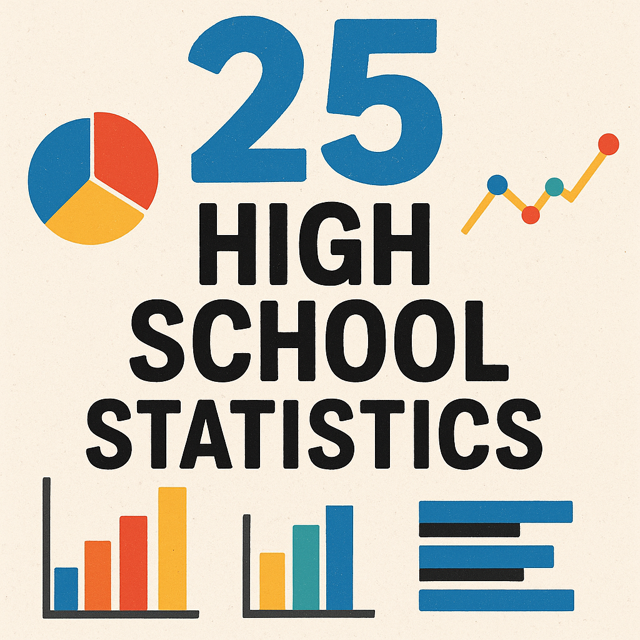
DISCOUNTED EDUCATION PRICING! CALL 1-877-891-8411. We Gladly Accept School Purchase Orders!

As we navigate through 2025, America’s high schools are changing faster than ever. From shifts in student mental health to the rise of AI in the classroom, the modern high school experience looks dramatically different from even five years ago.
Whether you’re a teacher, school administrator, parent, or education advocate, staying current with the latest high school statistics isn’t just helpful—it’s essential. These numbers tell a story of how students are learning, struggling, and thriving in today’s world.
Here are 25 high school statistics you need to know in 2025—and why they matter.
The national graduation rate has increased slightly over the past two years, reflecting post-pandemic recovery. However, disparities remain based on race, income, and geography.
Why it matters: Graduation is a critical predictor of future success. Tracking this number helps policymakers target support where it’s most needed.
According to the CDC’s Youth Risk Behavior Survey, student mental health continues to be a crisis—especially among girls and LGBTQ+ youth. A Pew Research study shows that teens now spend over 8 hours per day on screens
Why it matters: Schools need more than curriculum—they need mental health support systems.
Despite graduation gains, many students don’t feel ready for what comes next.
Why it matters: Readiness matters more than diplomas. High school should prepare students for life after 12th grade.
From personalized learning platforms to AI writing assistants, artificial intelligence has entered the classroom.
Why it matters: Understanding how these tools are used (and misused) is key to effective integration.
NAEP (National Assessment of Educational Progress) math scores took a hit during the pandemic and haven’t fully rebounded.
Why it matters: Foundational math skills are essential for future STEM success and everyday life.
Social media, gaming, schoolwork, and streaming all add up. The number continues to rise year-over-year.
Why it matters: Excessive screen time is linked to anxiety, sleep issues, and reduced academic focus.
Each one serves as a microcosm of its local community, with unique strengths and challenges. With the rise in outdoor learning, classrooms have started evolving
Hybrid and fully virtual options have gone mainstream, especially in rural areas.
Why it matters: Schools must ensure online learning is equitable, engaging, and rigorous.
According to NCES, funding varies significantly by state and district.
Why it matters: Students in underfunded schools face larger class sizes, outdated materials, and fewer enrichment opportunities.
Burnout, low pay, and growing demands are taking their toll.
Why it matters: Teacher turnover directly impacts student outcomes and school culture.
That number has doubled in the last decade.
Why it matters: Schools need culturally responsive teaching practices and targeted language support.
Larger schools often offer more programs, but smaller ones tend to foster stronger relationships.
Juggling academics and work is a reality for millions of teens.
Why it matters: Real-world experience is valuable—but overworking can hurt academic performance.
The American School Counselor Association recommends no more than 250:1.
Why it matters: Counselors are crucial for mental health, college prep, and crisis intervention.
Especially in life sciences and health pathways.
Why it matters: This marks progress in gender equity—but representation in tech and engineering still lags.
That number is even higher in urban schools.
Why it matters: Schools must ensure safe, inclusive environments for all identities.
Defined as missing 10% or more of school days, absenteeism is still a major post-COVID issue.
Why it matters: Absenteeism is one of the strongest predictors of academic failure.
Test-optional college admissions are reshaping standardized testing behavior.
Why it matters: Schools must reassess how they measure and support postsecondary readiness.
This number has stayed flat over the past 5 years, despite STEM push.
Arts aren’t fluff—they improve academic engagement, attendance, and school climate.
A growing number of programs are moving beyond the walls of the classroom.
Why it matters: Outdoor learning boosts attention, wellness, and real-world problem solving.
And about 20% say they’ve been bullied in the past year.
Why it matters: Anti-bullying programs must be proactive, not reactive.
Nicotine addiction remains a hidden crisis in high schools.
From financial literacy to mental health and conflict resolution.
Why it matters: Students are asking for relevance—schools should listen.
That includes apprenticeships, certifications, and degrees.
Why it matters: High schools must align their programs to the skills of the future—not just the tests of today.
High school is about so much more than textbooks and test scores. It’s a place where teens come of age, build identities, and prepare to enter the adult world. These 25 statistics don’t just reflect data—they reflect the lived experiences of millions of students, teachers, and families.
As we shape policy, design curriculum, or simply advocate for better schools, these numbers should inform every decision. Because behind each percentage is a student trying to thrive in a rapidly changing world.
Let’s give them the support, innovation, and opportunities they deserve.